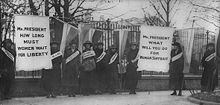

Jailed For Freedom
editDoris Stevens was born in 1888 in Omaha, Nebraska to a pastor father and an immigrant mother from Holland. She attended Omaha Highschool and later Oberlin College. At Oberlin College she became involved in women’s suffrage and became actively involved in advocating for women’s legal rights. After graduating, she moved to Washington D.C. and joined NAWSA as a regional organizer.
She wrote Jailed for Freedom, which was a firsthand account of her involvement with the more militant National Woman's Party and their fight for suffrage, published in 1920. It follows the story of Women's Suffrage and the repercussions of fighting for one's rights. Jailed for Freedom discusses how women picketing the White House were jailed and depicts the political and social tensions of that time. Stevens shares accounts of beatings, police brutality, and cruelty faced by women protesters, as well as the injustice faced by women in prison for standing up for their rights. Stevens was an organizer and a devout participant in the Silent Sentinels, protests which began in January 1917 outside of the White House, urging president Woodrow Wilson to pass the 19th Amendment. It was during these peaceful protests that Stevens and other suffragist women were arrested and jailed for their involvement.
Doris dedicated Jailed For Freedom to Alice paul, another leader of the National Woman’s party who was jailed alongside Doris during the Silent Sentinels. The book has three parts. Part 1 is titled Leadership and illustrates the work of Susan B. Anthony and Alice Paul. Part 2 is titled Political Action and talks about women organizing to protest the capital and President Woodrow Wilson to gain the right of suffrage. Part 3 is titled Militancy and talks about the violent, cruel backlash these militant women faced from authorities and in jail. It highlights the fight these women gave the capitol and how they finally succeeded in passing the 19th Amendment.